
If you’re planning a visit to Netherlands for tourism, business, or family reasons and intend to stay for up to 90 days, you may need to apply for a Dutch Short-stay visa, known as the Netherlands Schengen Visa.
Our visa experts have crafted the following guide to assist you at every stage of the Dutch Schengen visa application process. Filled with valuable insights and in-depth information based on our expertise, this comprehensive guide will aid you in thoroughly preparing for your upcoming Dutch adventure.

To apply for a visa to visit the Netherlands, follow these steps:
Whether you need a visa to visit the Netherlands or not will depend on your nationality.
You need a Schengen Visa to enter the Netherlands if you belong to one of the following categories:
You can visit the Netherlands and other countries in the Schengen Area for up to 90 days without a visa if you are from a country with a visa-free agreement. You are also exempt if you have a valid residence permit from a Schengen country.
You do need a visa to move to the Netherlands or for visits longer than 90 days, unless you are from an EU/EEA country or Switzerland.
If your plan involves a short trip to Netherlands, lasting up to 90 days, whether it’s for tourism, visiting friends and family, or business purposes, you should apply for a short-stay visa, commonly referred to as a C-type or Schengen Visa.
The Netherlands Schengen visa is issued for the following purposes:
You have to select the reason you are applying for the Netherlands Schengen visa when you fill out the application form. If your travel purpose does not match any of the previous reasons, you should check off “Other” and write down the reason.
Long stay visas for the Netherlands, also known as national visas or type D visas, are issued to people who want to live, work, or study in the Netherlands. They are issued for periods longer than 90 days, and allow the applicant to become a legal resident in the Netherlands. Long stay visas for the Netherlands include:
You can learn more about the Dutch long stay visas here.
As opposed to the Schengen visa, no one is exempt from long-stay visas other than EU/EEA and Swiss nationals.
| Residents of | Submit the application at |
|---|---|
| Albania, Bosnia and Herzegovina, North Macedonia, Serbia, Vatican City | The Dutch Embassy or Consulates in these countries |
| Belarus, Cyprus | The German Embassy or Consulates in these countries |
| Russia | The Portuguese Embassy |
| Monaco | The French Embassy |
| San Marino | The Italian Embassy |
| Moldova | The Hungarian Embassy |
| Montenegro | The Slovenian Embassy |
Residents in all other European countries not mentioned above have to submit their Dutch Schengen visa applications to the Dutch embassy or consulate in their country of residence.
| Residents of | Submit the application at |
|---|---|
| Benin, Mozambique, Sudan, Yemen, Zimbabwe | The Dutch Embassy or Consulates in these countries |
| Namibia | The German Embassy |
| Burundi | The Belgian Embassy |
| Cabo Verde, São Tomé and Príncipe | The Portuguese Embassy or Consulates in these countries |
| Central African Republic, Chad, Comoros, Mauritania, Mauritius, Niger, Togo | The French Embassy or Consulates in these countries |
| Eritrea | The Italian Embassy |
| Madagascar | The Swiss Embassy |
| Libya | The Tunisian Embassy |
Residents in all other African countries not mentioned above have to submit their Dutch Schengen visa applications to the Dutch embassy or consulate in their country of residence.
| Residents of | Submit the application at |
|---|---|
| Afghanistan, Georgia, South Korea, Syria, Taiwan, Yemen | The Dutch Embassy or Consulates in these countries |
| Turkmenistan | The German Embassy |
| Laos | The French Embassy |
| Macau | The Hong Kong Embassy |
Residents in all other Asian countries not mentioned above have to submit their Dutch Schengen visa applications to the Dutch embassy or consulate in their country of residence.
| Residents of | Submit the application at |
|---|---|
| Argentina, Chile, Colombia, Peru | The Dutch Embassy or Consulates in these countries |
| Paraguay, Uruguay | The Spanish Embassy or Consulates in these countries |
Residents in all other South American countries not mentioned above have to submit their Dutch Schengen visa applications to the Dutch embassy or consulate in their country of residence.
| Residents of | Submit the application at |
|---|---|
| Costa Rica, Cuba, Mexico, Trinidad and Tobago | The Dutch Embassy or Consulates in these countries |
| Belize | The Mexican Embassy |
| Jamaica | The Belgian Embassy |
| Haiti, Saint Lucia | The French Embassy or Consulates in these countries |
| El Salvador, Guatemala, Honduras, Nicaragua, Panama | The Spanish Embassy or Consulates in these countries |
| Saint Kitts and Nevis, Saint Vincent and the Grenadines | The Trinidad and Tobago Embassy |
Residents in all other Oceanian countries not mentioned above have to submit their Dutch Schengen visa applications to the Dutch embassy or consulate in their country of residence.
If Netherlands is the only country in the Schengen Area you plan to visit, it’s straightforward – apply at the Dutch embassy/consulate or the authorized Visa Application Center (VAC) in your country of residence.
However, if your journey includes Netherlands and at least one more Schengen state, apply at the Dutch embassy/consulate/VAC in your country of residence only if:
You can’t apply for a short-stay Dutch visa from a country where you are currently on a short-stay visa. You must hold a residence permit in the country where you are applying.
Once you know if you need a visa and where to lodge your application, the very first step is to complete the Netherlands visa application form online. Before you can start filling out the form, you should log in. If you don’t have an account already, sign up for an account on the Netherlands website.
To open an account, follow these steps:
See a step-by-step guide on filling out the application form for a Netherlands visa.
Please note that the nationalities and other information included in the form are chosen at random for instructional purposes only.
Enter your country of residence, which country in the Schengen area you want to visit (Netherlands in this case), and how many times you wish to enter (e.g., single, two entries, multiple entry). Additionally, enter your nationality. Next, write down the date you plan to arrive in the Schengen area and the date you plan to leave. The website will automatically count the total number of days you will spend in the country.
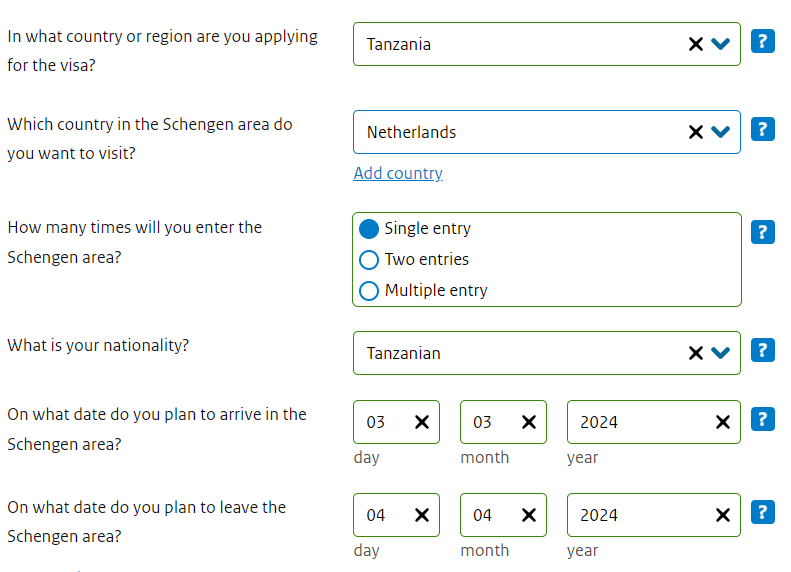
Under Personal Details, you must write down your Surname, Given name (Enter all information exactly as it appears on your travel document), Gender, Date of Birth, Place of Birth, Country of Birth, and Marital Status.
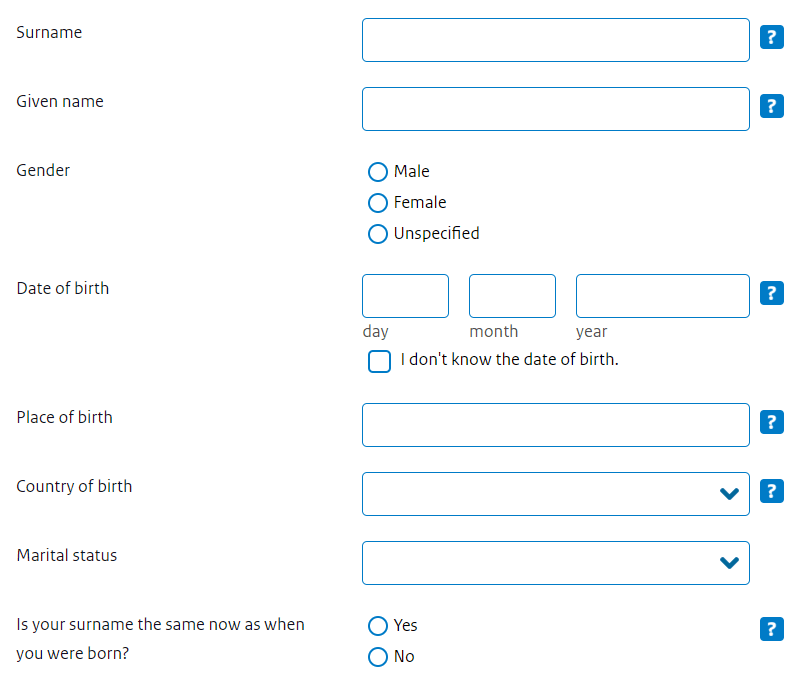
If you hold a different surname now than when you were born, select ‘No’ and fill in your surname at birth.
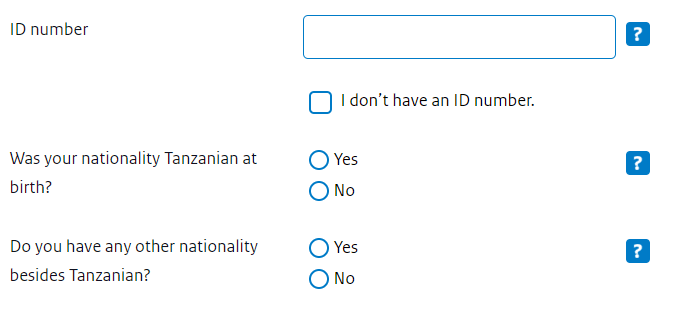
Under Nationality, you must enter your national identity number. In case you don’t have one, you can simply tick ‘I don’t have an ID number’.
In the Address section, you must write down your street address, number, postcode (if applicable), place of residence, and country. Additionally, select ‘Yes’ or ‘No’ if you are a national of the country you’re applying from. If you will return directly to your country of residence when you leave the Schengen area, select ‘Yes.’ If you will be travelling to a country outside the Schengen area before you return to your country of residence, select ‘No.’ In that case, you should prove that you are authorised to enter the other country, e.g., by showing a valid visa. If you will be travelling with a family member who is a national of the EU, EEA, Switzerland, or the UK, select ‘Yes’. Otherwise, select ‘No’.
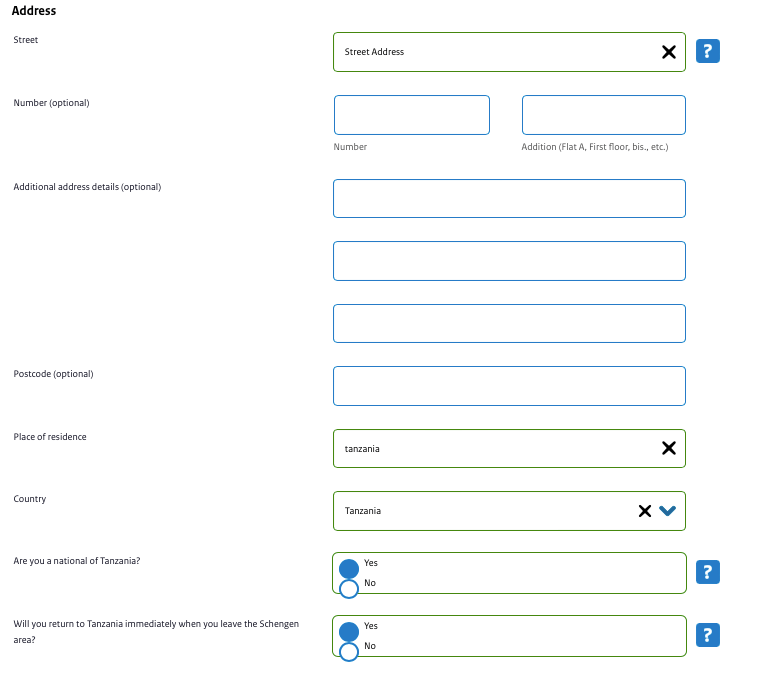
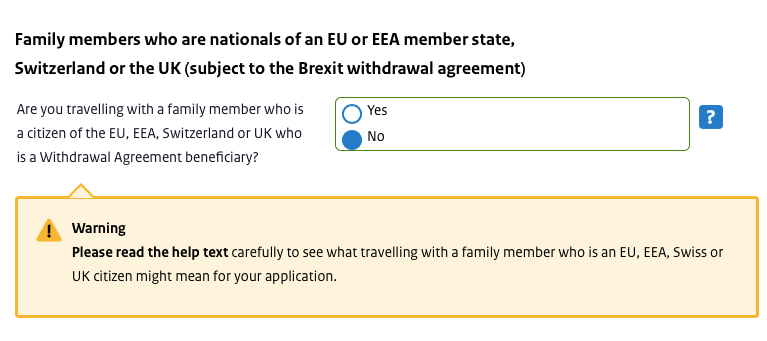
Select your occupation from the list. If you don’t see your occupation, select ‘Other’ and explain what you do.

Next, under ‘Employer’, you will be required to give additional information about your employer. Fill in all information correctly.
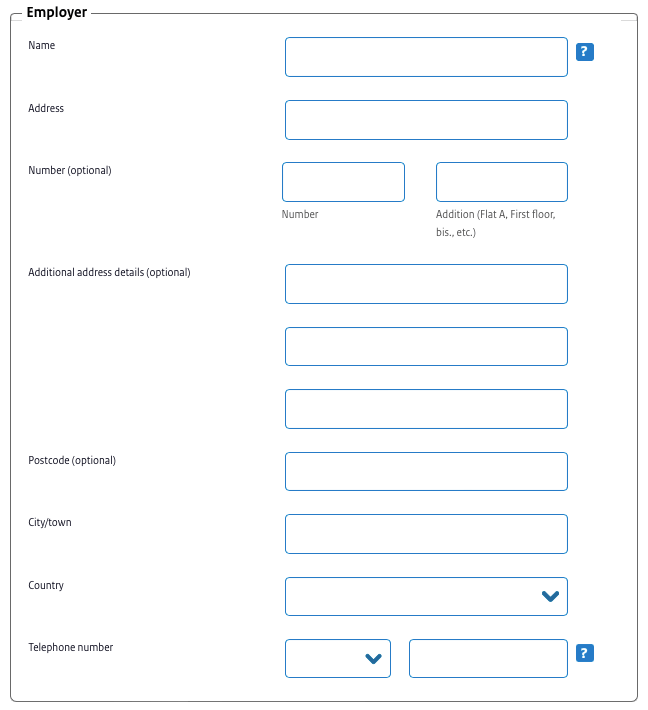
According to the answers you provide, you’ll have to provide different information. For example, if you are invited by a company or organisation, you will be asked to provide information about the company/organisation. Similarly, if you were invited by an individual, you will need to write down information about that individual.
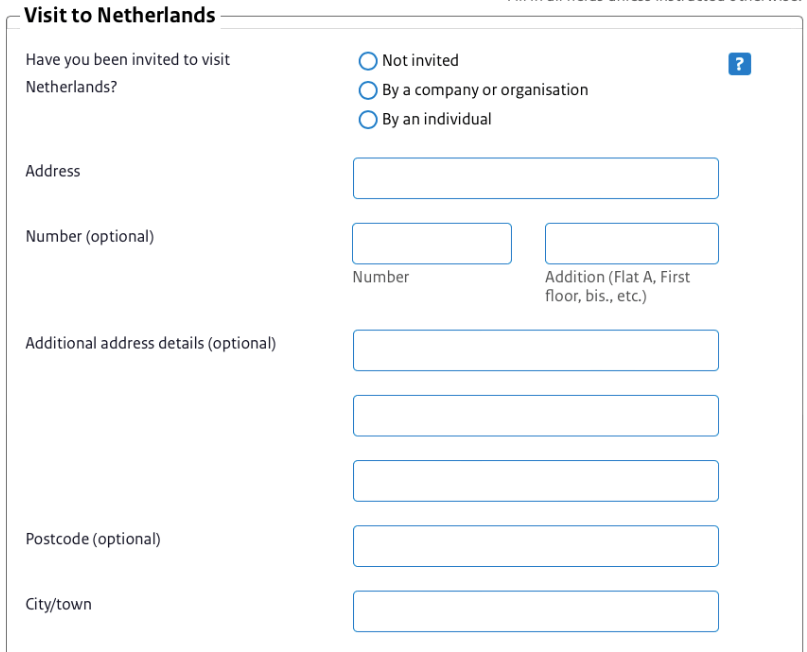
Under Means of Support, you must give information about who is going to sponsor your trip. If you’re going to sponsor yourself, select “By applicant/himself”. In that case, you will be asked to explain how you will be covering your travel and other expenses yourself. If someone else is going to sponsor your trip, select “Support by Other” and explain how, e.g., with cash, traveller’s cheques, etc.
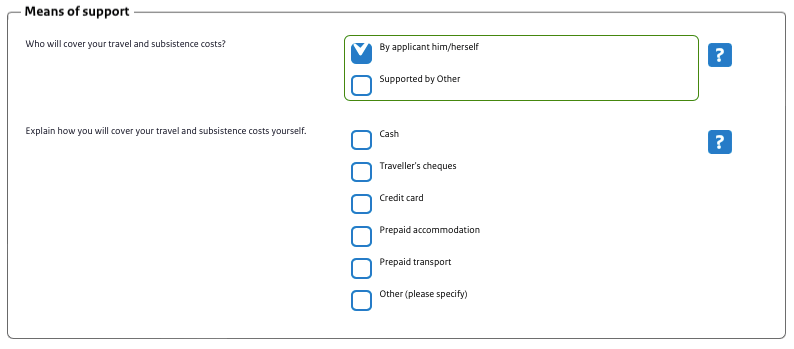
Lastly, select the main purpose of your trip. You must select one purpose from the provided list and provide additional information if necessary. If your visit serves multiple purposes, such as primarily Tourism, but you will also be visiting family or friends, you can specify that in the box below.
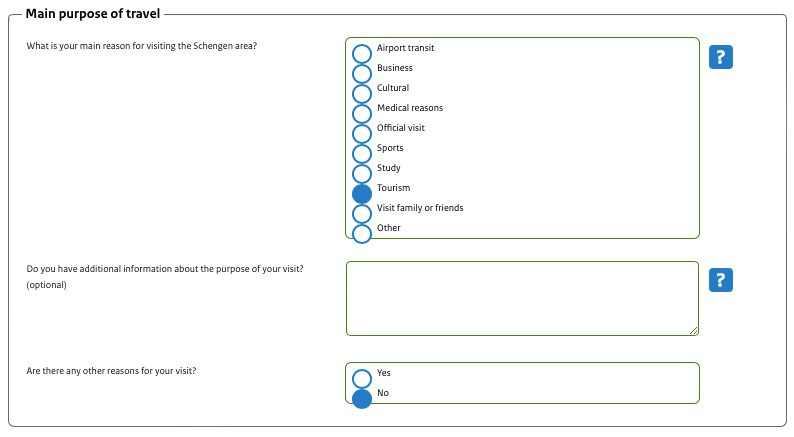
Once you’re done, you should print it out and submit it along with your other documents The estimated time to complete the application form is 30 minutes, which means you will be logged out after 30 minutes of inactivity. However, you can log back in at any time, and you’ll find your application form saved in ‘My Drafts,’ allowing you to continue without losing any information.
Once you are done with your application form, book an appointment online through the official website. Select your country of residence from the list, and you will be redirected to the specific visa application website for that country.
Scroll down until you find the Step 3: Make an Appointment section, and click on How do I make an appointment? As you can see, there’s going to be a link, which you can click on to set up your appointment.
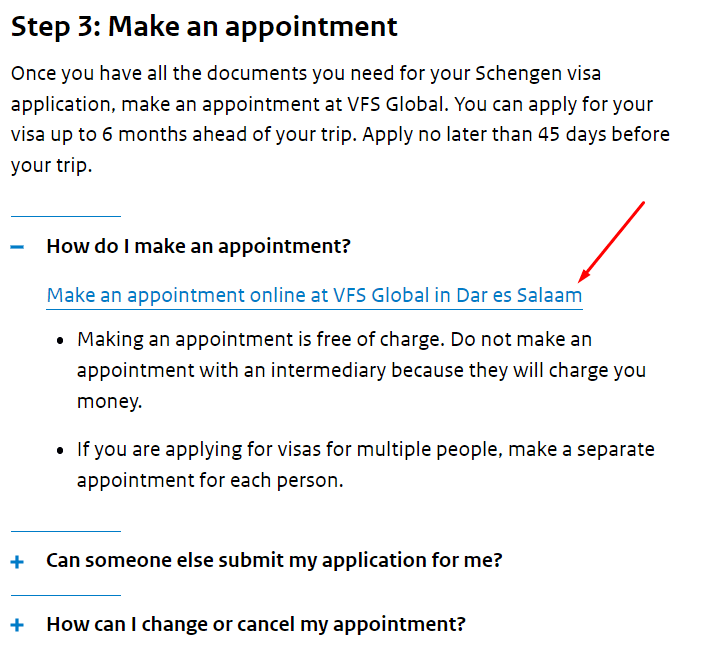
Remember, Tanzania was selected from the menu at random only for demonstration purposes. This process is similar regardless of where you live—just make sure to select your country of residence on the initial menu.
In cases where it is not possible to apply from your country of residence, you can apply from another country. See for example if you live in Albania, you are redirected to the Netherlands embassy in North Macedonia (a neighbouring country).
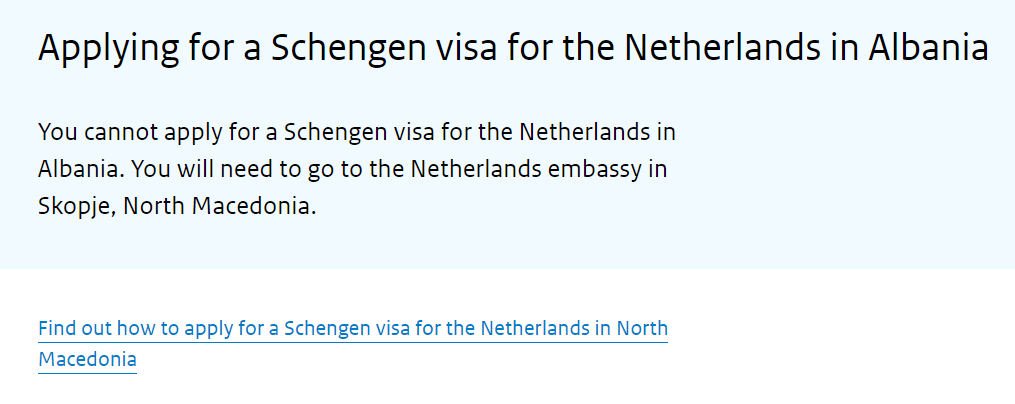
Similarly, if you live in Afghanistan, you can choose to apply from India, Iran, Pakistan, or the UAE.
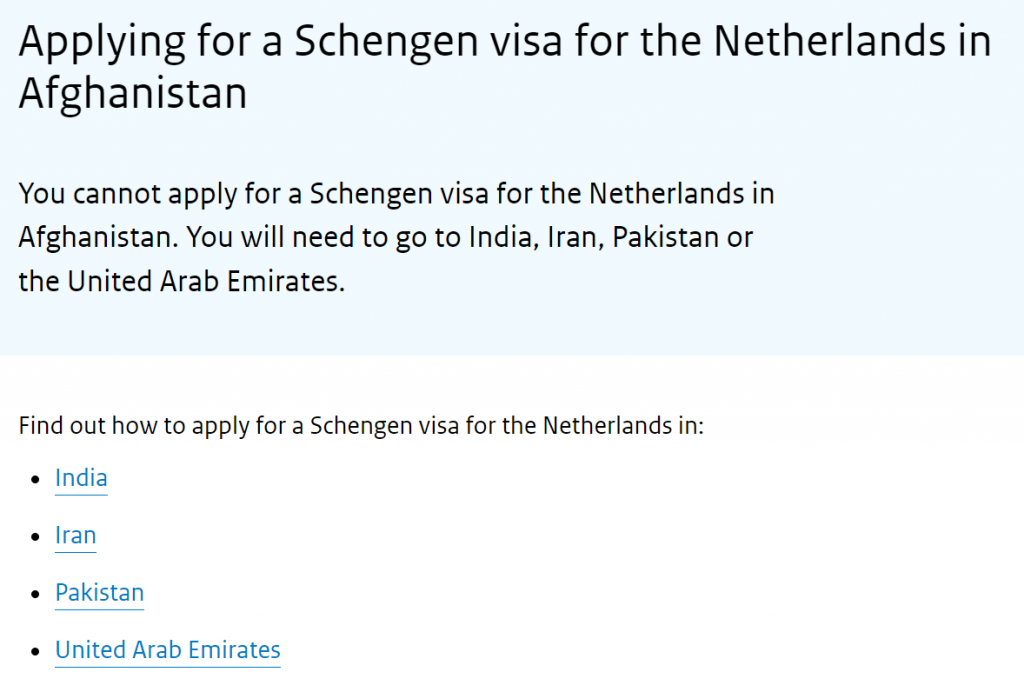
To change or cancel your appointment for a Netherlands visa, you have to contact the VFS Global centre, TLScontact, or Dutch embassy or consulate in which you applied.
Before you attend your appointment for a Netherlands Schengen visa, you have to collect a set of documents. This includes:
Make sure that you collect all, otherwise, your visa might be denied.
To apply for a Schengen visa to the Netherlands, you must submit proof that you have at least €55 to spend per day for the whole duration of your stay in the country. This can be through bank statements, credit cards, or cash.
Travel Medical Insurance is compulsory for Schengen visas under Regulation (EU) 2009/810 of the European Parliament.
Dutch visa applicants can obtain visa insurance from either Europ Assistance or vti.travel, a European insurance comparison website, comparing insurance policies of AXA, Allianz, Europ Assistance and Mutuaide.
These insurance providers are acknowledged and accepted by Dutch Embassies and Consulates worldwide. Moreover, you can cancel the insurance at no cost by submitting proof of Dutch visa rejection.
On the date of your appointment, make sure to show up on time and have your passport, documents, and enough money to pay the visa fee. That day, you also have to answer some short questions about your trip and submit your biometric information.
For the visa to the Netherlands to be processed, you have to pay a visa application fee—for adults the fee is €90 (children and certain categories may pay a reduced fee).
Accepted payment methods may vary depending on the embassy or visa application centre and can include credit/debit cards, cash, or payment slips.
Please note that if you apply through a visa application centre such as VFS or TLS, you need to pay an additional service fee, which can be from €10 to €40.
On the day of your appointment, you also have to submit a biometric visa photo as well as fingerprint scans.
This information is stored on VIS – the Schengen Visa Information System for identification purposes. If you have applied for a Schengen visa in the last five years and your fingerprint scans are still on VIS, you may be exempted from submitting them again.
The visa interview is short and consists only of a few questions about your trip, travel plans, and any personal information. For example, common questions asked at a visa application interview include:
Your Netherlands Schengen visa will take up to 15 working days to process. However, you must remember that this period can be prolonged if, for example, additional documentation is needed or there is a large number of applications (e.g. ahead of the holidays). You will be notified that your visa has been processed by the visa application centre or embassy consulate through the agreed-upon method (email or text message.)
While your visa is being processed, you can track the application; how you do this depends on where you submitted your application.
If you have applied with a Dutch embassy or consulate-general, you can track your application here. Just select the country in which you applied as well as the language in which you want the information to be presented to you. Next, just enter your tracking number, which is written on the card you received at your appointment.
If you have applied through VFS Global, you can track your application here. You have to select the country in which you applied and Netherlands as the destination. Click on the Track application button on the header and then on the link “track your visa application status online” Once redirected to the final page, you have to provide the reference number you received when you submitted your application and your last name.
If you applied through TLScontact, you can track your visa application here. Just select the centre in which you submitted your application, and log in to view your application status.
If the visa application is successful, the visa will be affixed to your passport, allowing you to travel to the Netherlands within the dates specified.
On the affixed visa sticker, you will see the visa’s validity dates, whether it is a single or multiple entry visa, as well as the number of days you are allowed to spend in Schengen in total.
If your Netherlands visa application is refused, the reason for the refusal will be stated on the decision letter/notification. Following this, you can either:
Once your visa application has been processed, you have to collect your passport. You can collect it in-person at the VFS, embassy or consulate, or TLS centre in which you applied. Alternatively, some visa centres will send you the passport through a courier service (you pay for this service upfront).
When you apply for a Netherlands visa, the visa officer who accepts your application will let you know how you can pick up your passport or it will be stated on the email or message you receive to let you know your visa has been processed.
Make sure you arrive in the Netherlands during the dates mentioned on your visa sticker. Here’s what you’ll need to have with you:
If you are already in the Netherlands with a Schengen visa and need to extend your stay, you can do so only in extraordinary circumstances. Schengen visas are only valid for a maximum of 90 days, so for an extension to be possible, you have to prove that circumstances beyond your control are prohibiting you from leaving the country.
If you meet the requirements listed above, then you can submit your application to extend your visa to the IND by calling and making an appointment. You need these documents:
You have to pay a fee of €30 when you submit your application at the IND.
Surinamese citizens aged 60 or older can extend their Schengen visa to more than 90 days once per stay without a special reason. The extension can be for up to 90 days. Once the extension is granted, the extended visa will only be valid within the Netherlands, Belgium, and Luxembourg.
If you need to stay in the Netherlands for longer than 90 days, for reasons such as studying, working, or joining a family member, you do not need a visa extension; you need a long-stay (type D) visa.
If you need a visa to visit the Dutch Caribbean, you can apply for one at a Dutch representative office abroad or visa application centre. Select your country of residence from the drop down list on the IND website to learn where you can submit your application for a visa to the Dutch Caribbean.
Similarly to the application for a regular Schengen visa, you must also fill out the Dutch Caribbean application form online.
You do not need a visa to visit the Caribbean parts of the Netherlands if you are from one of the following countries, or if you have a valid Schengen visa or residence permit.
If you do not require a visa to the Caribbean parts of the Kingdom, you can stay 90 days within a 180-day period.
Dutch or US nationals have the privilege of an extended stay, allowing for a maximum of 180 consecutive days within any 365-day period. For nationals of Schengen countries other than the Netherlands, a maximum stay of 180 days within a 365-day period is permissible in Aruba.
In the remaining Caribbean territories of the Kingdom, a stay of up to 90 days within a 180-day period is allowed as well. If you wish to stay longer, you should obtain a residence permit.
You are also exempt from a Netherlands visa for the Caribbean Part if you have one of the following visas:
Additionally, if you have a visa, a residence permit or proof of return for Saint Martin (the French part of the island), you do not need a visa to enter St Maarten (the Dutch part of the island)—but you do need one for the other Dutch Caribbean islands.
To enter the Caribbean Parts of the Kingdom, you must submit the following documents:
The validity of a Schengen Netherlands visa is 90 days within a 180-day period.
It is highly recommended that you do not overstay your visa. Overstaying your visa does not go unnoticed or is left unpunished.
You are free to visit other Schengen countries, unless you have a Limited Territorial Validity Visa.
There are non-Schengen/EU countries where you can go with a Netherlands Schengen visa if you meet specific requirements.
No, you cannot. You are not permitted to take part in any activity that is not specified in your visa, such as employment and others.
Please keep in mind that prior to completing your application, you will have the opportunity to grant consent for the processing of your data. Your data is protected and shared with The Schengen Visa Information System (VIS), BAO, and the National Visa Information System for up to five years. Additionally, you have the right to inquire about the information stored about you in the National Visa Information System and BAO.
Should you have any inquiries or requests regarding your personal data, please direct them to: